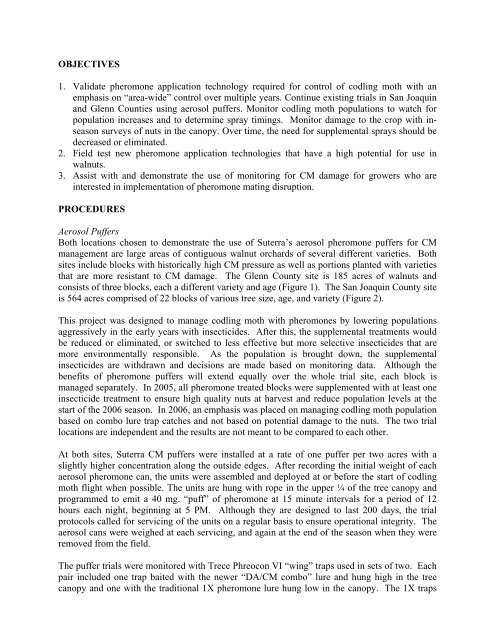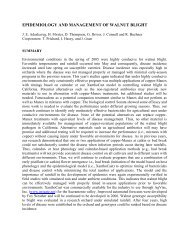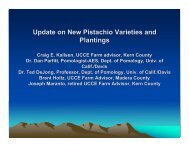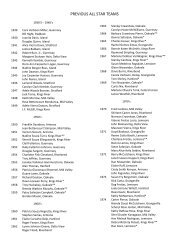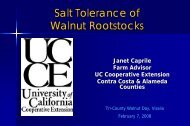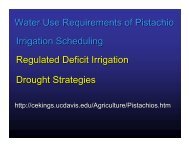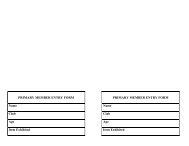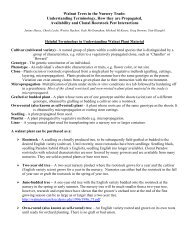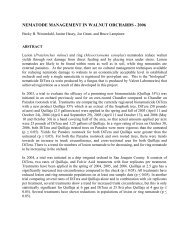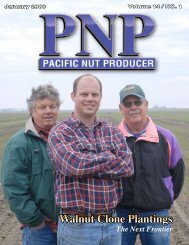using aerosol pheromone âpuffersâ - Walnut Research Reports
using aerosol pheromone âpuffersâ - Walnut Research Reports
using aerosol pheromone âpuffersâ - Walnut Research Reports
You also want an ePaper? Increase the reach of your titles
YUMPU automatically turns print PDFs into web optimized ePapers that Google loves.
OBJECTIVES<br />
1. Validate <strong>pheromone</strong> application technology required for control of codling moth with an<br />
emphasis on “area-wide” control over multiple years. Continue existing trials in San Joaquin<br />
and Glenn Counties <strong>using</strong> <strong>aerosol</strong> puffers. Monitor codling moth populations to watch for<br />
population increases and to determine spray timings. Monitor damage to the crop with inseason<br />
surveys of nuts in the canopy. Over time, the need for supplemental sprays should be<br />
decreased or eliminated.<br />
2. Field test new <strong>pheromone</strong> application technologies that have a high potential for use in<br />
walnuts.<br />
3. Assist with and demonstrate the use of monitoring for CM damage for growers who are<br />
interested in implementation of <strong>pheromone</strong> mating disruption.<br />
PROCEDURES<br />
Aerosol Puffers<br />
Both locations chosen to demonstrate the use of Suterra’s <strong>aerosol</strong> <strong>pheromone</strong> puffers for CM<br />
management are large areas of contiguous walnut orchards of several different varieties. Both<br />
sites include blocks with historically high CM pressure as well as portions planted with varieties<br />
that are more resistant to CM damage. The Glenn County site is 185 acres of walnuts and<br />
consists of three blocks, each a different variety and age (Figure 1). The San Joaquin County site<br />
is 564 acres comprised of 22 blocks of various tree size, age, and variety (Figure 2).<br />
This project was designed to manage codling moth with <strong>pheromone</strong>s by lowering populations<br />
aggressively in the early years with insecticides. After this, the supplemental treatments would<br />
be reduced or eliminated, or switched to less effective but more selective insecticides that are<br />
more environmentally responsible. As the population is brought down, the supplemental<br />
insecticides are withdrawn and decisions are made based on monitoring data. Although the<br />
benefits of <strong>pheromone</strong> puffers will extend equally over the whole trial site, each block is<br />
managed separately. In 2005, all <strong>pheromone</strong> treated blocks were supplemented with at least one<br />
insecticide treatment to ensure high quality nuts at harvest and reduce population levels at the<br />
start of the 2006 season. In 2006, an emphasis was placed on managing codling moth population<br />
based on combo lure trap catches and not based on potential damage to the nuts. The two trial<br />
locations are independent and the results are not meant to be compared to each other.<br />
At both sites, Suterra CM puffers were installed at a rate of one puffer per two acres with a<br />
slightly higher concentration along the outside edges. After recording the initial weight of each<br />
<strong>aerosol</strong> <strong>pheromone</strong> can, the units were assembled and deployed at or before the start of codling<br />
moth flight when possible. The units are hung with rope in the upper ¼ of the tree canopy and<br />
programmed to emit a 40 mg. “puff” of <strong>pheromone</strong> at 15 minute intervals for a period of 12<br />
hours each night, beginning at 5 PM. Although they are designed to last 200 days, the trial<br />
protocols called for servicing of the units on a regular basis to ensure operational integrity. The<br />
<strong>aerosol</strong> cans were weighed at each servicing, and again at the end of the season when they were<br />
removed from the field.<br />
The puffer trials were monitored with Trece Phreocon VI “wing” traps used in sets of two. Each<br />
pair included one trap baited with the newer “DA/CM combo” lure and hung high in the tree<br />
canopy and one with the traditional 1X <strong>pheromone</strong> lure hung low in the canopy. The 1X traps


